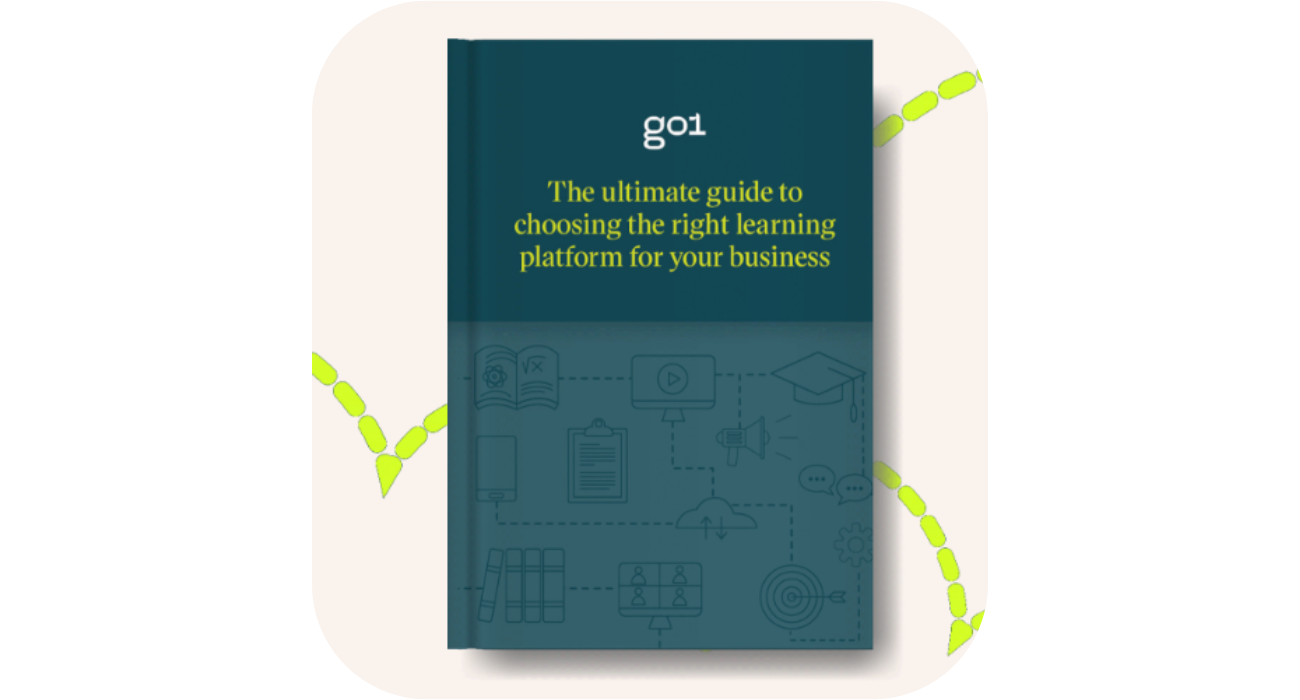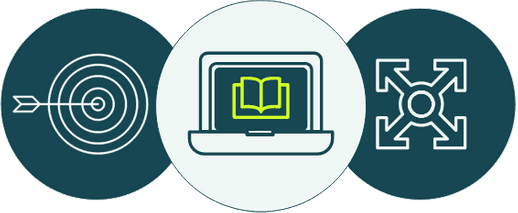The ultimate guide to choosing the right learning platform for your business

Selecting an LMS is vital for any HR or People Operations team. Harnessing L&D to instill a love of learning in your employees can take your company to the next level.
In fact, a robust learning culture is a key attribute that differentiates top-performing organizations. High-impact learning cultures (defined as the top 10% of L&D teams) spend 7% more of their budget on learning technologies than the average organization (28% versus 21%). And this is only the tip of the iceberg.
Further statistics demonstrate the immense value of an LMS. For example:
- 72% of organizations use an LMS to gain a competitive advantage
- Every dollar invested in online learning results in $30 worth of productivity
- 56% of employees say career growth and opportunity via workplace learning is more 56 important than salary
- 76% of people say a company would be more appealing if it offered additional skills training
Therefore, a high-quality LMS can be the difference between boosting your ROI and attracting top talent or losing leading employees to your competitors.
Given this, choosing an LMS is not a decision that should be made lightly. It’s not as simple as randomly picking a name out of a hat — each LMS has distinct benefits, features, and drawbacks, as we will discuss throughout this guide. What’s perfect for one team may be the wrong fit for another. Selecting an LMS to suit your team’s unique needs should be a considered process that accounts for the pros and cons of each provider, as well as your learners’ requirements and your overall business goals.
Unfortunately, it’s not always that easy. As with anything in the L&D world, obstacles arise. Budgets are tight, with 42% of L&D teams citing “lack of budget” as their biggest challenge. Concerningly, 81% of teams also face barriers to learning. Likewise, while 95% of L&D teams say “digital content development” is a priority, only 29% have the competency to deliver on this goal. Thus, while the majority of teams recognize that selecting the right LMS is vital, few have the appropriate skills and resources to do so. Throughout this guide, we want to change that.
We know that choosing an LMS can be an intimidating task. With so many competing options and different stakeholders to please, how do you choose an LMS that will please everyone? Luckily, you’re in the right place. This LMS buyer’s guide will show you how to remove these obstacles, revealing everything you need to know about choosing the right LMS for your business. From setting goals to booking demos, we’ll take you through each step of the buying process so you can approach buying an LMS with confidence.
In chapter one, we’ll set you up for success by discussing everything you need to know before getting started, including securing stakeholder buy-in, questions to ask when choosing an LMS, setting measurable goals, establishing a realistic timeline, and surveying your learners to determine their needs and preferences. Think of it as laying the foundation.
Next, in chapter two, it’s time to get down to business by defining your content preferences – this will enable you to choose the right LMS for your learners’ and business’ needs. Following this, in chapter three, we’ll discuss the research and evaluation phase, detailing essential tips for meeting with vendors and evaluating product demos. Finally, in chapter four, we’ll help you put it all together by discussing implementation and how to extract maximum impact from your new LMS.
At Go1, we know that choosing an LMS can be tricky. So, we’re here to make it easy. Whether you’re a CEO, an HR manager, or an employee who wants more learning opportunities in your workplace, this guide is for you. We’re here to help you choose the perfect LMS to take your business to the next level!

Ready for the next chapter?
Download the full e-book to discover:
- What to do before contacting vendors
- How to define your content preferences
- What to expect from the buyer process
- How to implement your learning platform
First things first, congratulations! Buying an LMS is an extremely exciting step, and we want to ensure it’s not a painful one. We know that buying an LMS can be intimidating at first; there are so many different providers to choose from, diverse stakeholders to please, and oodles of research to complete. Where do you even start?
In this chapter, we’ll help you take the first steps on your buying journey, outlining everything you need to do before you start calling vendors. While you’re probably eager to dive right in, following these initial steps will allow you to lay the foundation and set yourself up for long-term success. Trust us, your learners will thank you!
Defining your goals
When setting out on your LMS buying journey, the first and most important step is to ask yourself one simple question: ‘Why?’ What does our business hope to achieve by purchasing an LMS? The answer to this question will inform every subsequent decision you make throughout the buying process. Without defining clear, measurable goals from the outset, you are dooming yourself to muddled thinking and long-term failure. There are many possible ways to answer this question. Perhaps you are looking to upskill your workforce. Maybe you need to roll out compliance content on a larger scale. Or you could be looking for an LMS that allows your employees to learn on the go. Each business will have different goals and objectives. Whatever your specific goals, it is imperative to make them clear, specific, timebound, and measurable. For example, ‘We want to improve learner engagement’ is too broad. On the other hand, ‘We want to improve learner engagement by 5% quarter over quarter’ is a far more well-defined and achievable goal.
To set realistic goals, you also need to define your budget. According to research by Capterra, the median organization spends $10,243 on its LMS per year. 42% of organizations spend $1,001-10,000 per year on their LMS, with 19% spending $10,001-50,000 and 29% spending $1-1,000.
Finally, we recommend aligning your L&D goals with your broader organizational strategy. According to Emerald Works’ Back to the Future report, 94% of highimpact learning cultures (defined as the top 10% of L&D teams) say their L&D activity aligns with their organization’s strategic goals. By comparison, just 49% of other L&D teams say the same. This massive discrepancy underscores the importance of aligning your L&D and organizational goals.
Getting stakeholder buy-in
Buying an LMS will have far-reaching impacts throughout your business, from employees to managers, all the way up to the C-suite. Accordingly, you must engage stakeholders early in the purchasing process to secure buy-in and ensure everyone is on the same page.
Yet, stakeholder buy-in is an area where many L&D teams struggle. According to recent research, 26% of HR managers fail to attain leadership buy-in for L&D initiatives, while 25% fail to gain employee buy-in. Evidently, stakeholder buy-in is a common pitfall that you must address early.
To stay on top of this, you need to identify your stakeholders. These may include:
- HR leaders
- Subject matter experts
- Managers
- Executives
- Administrators
- Tech support
- Designers
- End-users
Basically, you should consult anyone who will be impacted by purchasing an LMS. You should also invite stakeholders who will have to sign off on the ultimate buying decision, you should also invite them to be part of the buying committee (more on that in chapter three).
Securing stakeholder buy-in will vary from business to business. Some organizations may already understand the value of L&D, while others may need a little more convincing. Whatever stage of learning maturity you’re at, try to communicate the benefits and impacts of an LMS in terms that will resonate with that particular stakeholder. For example, you may focus on increased ROI when seeking buy-in from an executive. Or, you might want to emphasize learner engagement and talent retention when talking to HR leaders.
Securing stakeholder buy-in should also involve surveying stakeholders to determine their needs and concerns. Questions you may want to ask include:
- Do you have any reservations about buying an LMS? If so, how can we address these concerns?
- What needs do you want an LMS to address?
- What are your functionality preferences for an LMS? Are there any features you consider a must-have?
- What are your content preferences? For example, would you prefer multimedia content? Learning on the go? Text-based quizzes?
- Are there particular topics you want to learn more about?
- Are there any areas where you would like to upskill?
- How long would you ideally like to spend learning?
Ultimately, you can buy the most up-to-date LMS with all the flashiest new features, but without buy-in from your key stakeholders, the project is doomed to fail. Getting stakeholder buy-in — and keeping your stakeholders in the loop throughout the buying process — is an essential step you must not ignore.
Establishing a timeline
We’ve established the what (buying an LMS), why (by setting clear goals), and who (by engaging key stakeholders). Now, it’s time to tackle a commonlyoverlooked question: when?
Buying an LMS can be a time-consuming, research-intensive process. Between narrowing down your options, getting everyone on board, booking demos, and rolling out your new LMS, it can take a while to dot all the I’s and cross all the T’s. As such, you must manage everyone’s expectations by establishing a clear timeline.
Whether you want your new LMS in three months, six months, or two years will depend on your unique circumstances. Either way, your timeline must be realistic. There’s nothing worse than promising a shiny, new LMS within three months, only to have the process drag on and take twice as long.
According to research by Capterra, 62% of organizations take 1-6 months to purchase an LMS. 21% take less than one month, while 17% take more than seven months.
Interestingly, there is a discrepancy between how long teams think it will take to purchase an LMS and how long it actually takes. 32% of teams expect it to take 1-3 months to purchase an LMS, compared to 28% of teams that actually take that long.
Given this, it is vital to establish a realistic timeline and stick to it as closely as possible. That way, everyone is on the same page!
Getting your learners onboard
It’s well and good to set your goals, get stakeholder buy-in, and establish a timeline. However, if you fail to get your learners onboard, all of this will be for nothing. After all, an LMS is pointless without any learners to use it. Nevertheless, this is an area in which many businesses fail to invest enough time and effort!
It’s not enough to simply purchase an LMS and expect learners to flock to it in droves. Rather, you must communicate the value of your new LMS, engage learners throughout the buying process, and seek their input. One of the simplest ways to do this is to conduct a learner needs analysis. Put simply, this means surveying your learners to ask them what they want from an LMS. Is there a specific style of learning they’d prefer? A particular genre of content? After all, they will be using it, so their needs should be front and center — especially during the early stages while you are still establishing your goals and narrowing down your content preferences.
Unfortunately, as mentioned, this is an area where many businesses fail. Onequarter of HR managers say employee buy-in is a significant obstacle when launching L&D initiatives.
Moreover, 66% of people say they face at least one barrier to learning at work, with the most common barriers being ‘Learning isn’t available in times or ways that suit me’ (23%) and ‘I don’t know where to start in terms of learning’ (17%).
Address these obstacles in the early stages of buying an LMS to ensure learners are clear on when, where, and how they can access learning.
It may sound straightforward, but simply asking your employees what they want from an LMS and communicating with them throughout the buying process can make a world of difference!
To learn more, read our whitepaper on 5 things to get in place before launching eLearning.

Read the full e-book
You'll learn how to:
- Get stakeholder buy-in
- Establish a timeline
- Assemble your buying committee
- Schedule demos
- Get maximum impact from your new learning platform





